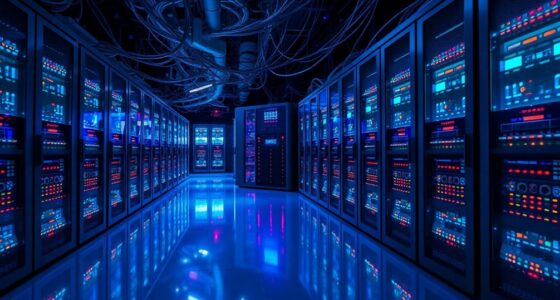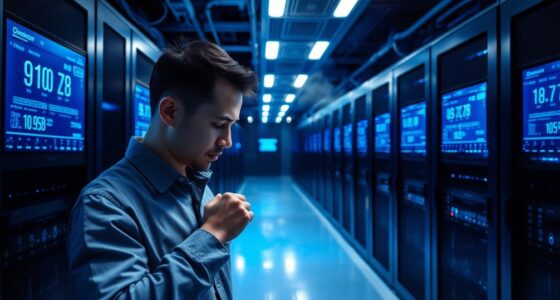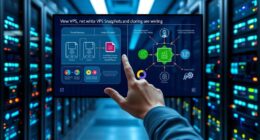Your choice of data center location affects more than just connections; it impacts performance, security, and sustainability. Being close to endpoints reduces latency and boosts response times for your applications and IoT devices. It also influences how easily you access renewable energy sources, supporting eco-friendly goals. Additionally, location plays a role in protecting your data from natural disasters and political risks. Keep exploring because understanding these factors can help you make smarter, more resilient decisions for your infrastructure.
Key Takeaways
- Proximity to edge devices reduces latency, enabling real-time data processing and improved user experience.
- Location influences access to renewable energy sources, supporting sustainability and lowering operational carbon footprint.
- Geopolitical stability and infrastructure quality ensure regulatory compliance, security, and reliable data transfer.
- Natural disaster risks and physical threats vary regionally, affecting data center resilience and disaster recovery strategies.
- Strategic placement optimizes performance, security, energy use, and maintenance logistics, maximizing overall operational efficiency.

Have you ever wondered how the location of a data center impacts its performance and security? The placement of these facilities isn’t just a matter of convenience; it plays a vital role in how efficiently your data is processed, stored, and protected. When you think about edge computing, for example, proximity becomes essential. Edge computing pushes data processing closer to the source—think of IoT devices, sensors, or local offices—reducing latency and improving response times. If a data center is situated far from these endpoints, delays increase, and your applications could lag, hampering productivity and user experience. Conversely, a well-located data center near the edge ensures rapid data transfer, making real-time decisions smoother and more reliable.
Strategic data center placement enhances performance, security, and real-time responsiveness through proximity to edge devices and local sources.
Another significant factor tied to location is energy sources. As awareness about sustainability grows, the emphasis on renewable energy becomes more prominent. Data centers consume vast amounts of power, and choosing a location powered by renewable energy sources like wind, solar, or hydroelectric power can drastically reduce their carbon footprint. If a data center is positioned in a region abundant in renewable energy, it aligns with eco-friendly initiatives and helps companies meet environmental, social, and governance (ESG) goals. This isn’t just about corporate responsibility but also about operational stability. Regions with renewable energy tend to have more stable, predictable power supplies, reducing the risk of outages caused by grid instability or fossil fuel shortages.
Security also hinges heavily on location. Data centers situated in remote, less accessible areas can be more protected from physical threats like vandalism or natural disasters, but they might face logistical challenges, such as difficult access for maintenance. Conversely, locations near urban centers offer easier access but could be more vulnerable to targeted attacks or natural calamities like earthquakes or floods. The key is balance—selecting a site that offers natural protection while enabling swift response and maintenance.
Furthermore, geopolitical stability influences a data center’s security and compliance. Regions with political turmoil or unstable governments pose risks of disruptions or data sovereignty issues. Choosing a location with stable governance and clear legal frameworks ensures your data remains secure and compliant with regulations. Infrastructure quality, connectivity, and proximity to major network hubs also matter; a strategically positioned data center benefits from robust fiber optic links and faster connections, which directly impact performance. Additionally, the use of cold-pressed vegetable juice or similar methods in cooling data centers can enhance energy efficiency by reducing reliance on traditional cooling systems.
Ultimately, the right location isn’t just about geography. It’s a strategic choice that affects your data’s speed, security, sustainability, and resilience. By considering edge computing needs, renewable energy availability, security, and geopolitical stability, you can guarantee your data center supports your goals efficiently and responsibly.
Frequently Asked Questions
How Does Climate Affect Data Center Efficiency?
Climate substantially impacts data center efficiency by influencing cooling strategies. In hot or humid climates, you need robust cooling solutions, which increase energy consumption. Cooler regions allow you to implement natural cooling methods, reducing costs and environmental impact. Climate considerations help you choose a location with ideal conditions, ensuring your data center operates efficiently and sustainably. Proper planning around climate factors can save you money and improve overall performance.
What Role Do Local Laws Impact Data Center Operations?
Think of local laws as the invisible hands guiding your data center’s dance. They shape your operations through regulatory compliance, ensuring you follow rules that keep your business safe and lawful. Tax incentives act like a compass, pointing you toward financial advantages that can lower costs and boost growth. Ignoring these laws risks penalties, while embracing them can turn your data center into a well-oiled machine thriving within the legal landscape.
How Does Proximity to Customers Influence Latency?
Proximity to customers substantially affects latency, especially with edge computing gaining popularity. When your data center is close, data travels faster, reducing delays and improving user experience. This also helps address data sovereignty concerns, as local laws protect data within specific borders. By placing data centers near your customers, you guarantee quicker access, better compliance, and optimized performance, making your services more reliable and responsive in today’s fast-paced digital world.
What Are the Risks of Choosing a Remote Location?
Sure, choosing a remote site might seem charming, like a secret hideaway—until you face remote site challenges. Logistical concerns such as limited access, power reliability, and maintenance delays can turn your dream into a nightmare. You risk increased downtime, higher costs, and security issues. So, while a remote location may seem idyllic, it’s often a gamble with your data’s safety, performance, and your peace of mind.
How Does Energy Infrastructure Vary by Region?
You should consider how energy infrastructure varies by region because it directly impacts your data center’s efficiency and resilience. Regions with strong renewable energy sources and reliable infrastructure resilience guarantee a steady power supply and lower carbon footprint. By choosing a location with robust energy infrastructure, you reduce downtime risks and support sustainable operations, making your data center more dependable and environmentally friendly.
Conclusion
Choosing the right data center location is like planting a sturdy tree—its roots determine strength, growth, and resilience. You might think it’s just about convenience or cost, but it’s really about setting your digital foundation on solid ground. When your data’s home is wisely chosen, it’s like a lighthouse guiding your business safely through storms. Remember, where you place your data isn’t just geography; it’s the heartbeat of your success story.









